Posts Tagged ‘veterinarians Glen Carbon’
How Do I Know It’s Time To Euthanize My Pet?
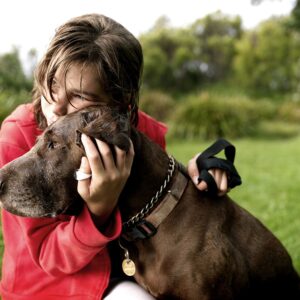 Some pets die of old age in the comfort of their own home, but many others become seriously ill or get injured in a way or experience that significantly diminishes their quality of life as they grow very old. In these situations, owners are often forced to consider the hard choice of whether to have your pet euthanized in order to spare your pet from pain and suffering.
Some pets die of old age in the comfort of their own home, but many others become seriously ill or get injured in a way or experience that significantly diminishes their quality of life as they grow very old. In these situations, owners are often forced to consider the hard choice of whether to have your pet euthanized in order to spare your pet from pain and suffering.
To know when it is time, it is important to talk with your veterinarian. They are the best-qualified person to help guide you through this difficult process. In some cases, your veterinarian may be able to tell you definitively that it is time to euthanize your pet, but in other cases, you may ultimately need to make the decision based on your observances of your pet’s behavior and attitude.
Some signs that your pet is suffering and no longer enjoying a good quality of life include chronic pain being experienced that cannot be controlled with medication, frequent vomiting or diarrhea that is causing dehydration and/or weight loss, they stop eating, incontinence, lost interest in favorite activities, cannot stand on their own, and/or chronic labored breathing. It is a very difficult decision, but one must consider your pet’s quality of life.
Once you have made the very difficult decision, you also need to decide how and where you and your family will say the final goodbye. Before the procedure is scheduled to take place, make sure that all members of your family have had time with the pet to say a private goodbye. If you have children, make sure that you explain the decision to them and prepare them for the loss of the pet in advance. This may be your child’s first experience with death, and it is very important for you to help her or him through the grieving process. Books that address the subject, such as When a Pet Dies by Fred Rogers or Remembering My Pet by Machama Liss-Levinson and Molly Phinney Baskette, may be very beneficial in helping your child to deal with this loss. It is an individual decision whether or not you and your family want to be present during the euthanasia procedure. For some pet owners, the emotion may be too overwhelming, but for many, it is a comfort to be with their pet during the final moments. It may be inappropriate for young children to witness the procedure since they are not yet able to understand death and may also not understand that they need to remain still and quiet.
Deciding when it is time to say goodbye to your pet is never easy. Owners are put into the difficult decision of deciding when it is their time. While it is never easy, the staff at Olsen Veterinary Clinic are always here to answer whatever questions you may have. Feel free to reach out at 618-656-5868 with any questions or concerns you may have!
What You Need To Know About Canine Flu Season

Canine influenza is a highly contagious viral infection that affects dogs and cats. Influenza viruses are able to quickly change and give rise to new strains that can infect different species. Of the two strains identified in the US, both of them can be traced to influenza strains known to infect species other than dogs. At some point, these viruses acquired the ability to infect dogs and be transmitted from dog to dog. Virtually all dogs exposed to canine influenza become infected, with approximately 80% developing clinical signs of disease. The other 20% of infected dogs that do not exhibit clinical signs of the disease can still shed the virus and spread the infection.
Canine influenza is transmitted through droplets or aerosols containing respiratory secretions from coughing, barking, and sneezing. Dogs in close contact with infected dogs in places like kennels, groomers, day care facilities, and shelters are at an increased risk of infection. Canine influenza can be spread indirectly through objects like kennels, food and water bowls, collars, and leashes or people who have been in contact with an infected dog to avoid exposing other dogs to the virus. Due to this, people in contact with an infected dog should wash their hands and clean their clothing to avoid spreading the virus. The virus can stay alive and able to infect on surfaces for up to 48 hours, on clothing for 24 hours, and on hands for 12 hours. It is important to implement cleaning and disinfection procedures to reduce the risk of disease transmission.
The majority of infected dogs exhibit the mild form of canine influenza. The most common clinical sign is a cough that persists for 10-21 days despite treatment with antibiotics and cough suppressants. Affected dogs may have a soft, moist cough, or a dry cough similar to that induced by kennel cough. Nasal and/or ocular discharge, sneezing, lethargy, and anorexia may also be observed. Many dogs developed a purulent nasal discharge and fever. Some dogs are more severely affected and exhibit clinical signs of pneumonia, such as a high-grade fever and increased respiratory rate and effort.
Canine influenza cannot be diagnosed solely by clinical symptoms like coughing, sneezing, and nasal discharge because these signs also present with other canine respiratory illnesses. Tests must be done to properly identify strains of canine influenza virus. Contact Dr. Olsen to set up a test if you think that your dog may be infected.
Treatment for canine influenza is largely supportive. Good nutrition helps dogs mount an effective immune response. Most dogs recover from canine influenza within two to three weeks. Secondary bacterial infections, pneumonia, dehydration, or other health factors may require additional diagnostics and treatments.
While canine influenza is a serious threat, vaccines are available against both strands of canine influenza found in the US. Vaccination can reduce the risk of a dog contracting canine influenza and while it may not all together prevent an infection; it may reduce the severity and duration of illness. As always, feel free to contact Dr. Olsen at 618-656-5868 with any questions or to set up an appointment!
The How And Why Of Trimming Your Dog’s Toenails
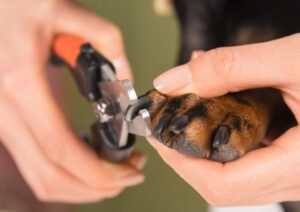 One of the most difficult things to do with your dog is to trim their nails; especially if they don’t like having their nails cut. Trimming your dog’s nails is an important grooming task that helps them stay happy and healthy. When their nails grow too long, health problems could occur. Dogs that run around on hard surfaces like concrete or blacktop, their nails are often worn down naturally. For dogs that spend most of their time indoors or running around on soft surfaces, their nails don’t get worn down regularly.
One of the most difficult things to do with your dog is to trim their nails; especially if they don’t like having their nails cut. Trimming your dog’s nails is an important grooming task that helps them stay happy and healthy. When their nails grow too long, health problems could occur. Dogs that run around on hard surfaces like concrete or blacktop, their nails are often worn down naturally. For dogs that spend most of their time indoors or running around on soft surfaces, their nails don’t get worn down regularly.
Nails that are too long are at risk of being torn off. This can result in an injury that could require veterinary care if it is serious enough. Longer nails also make it harder for dogs to walk around comfortably. If a dog’s nails hit the floor constantly as they walk, more pressure is put onto the nail bed that can cause discomfort that forces your dog to distribute their weight differently while they walk. In the end, this all can cause the way their toe and paw joints are aligned to be affected in a negative way.
If your dog is not used to having their nails trimmed, one should start getting them used to the clippers and having their paws handled. You can do this by forming a positive association with it by rewarding them with treats and praise until they allow you to clip their nails without getting too nervous.
There are several types of dog nail trimmers including scissors, guillotine-type, and grinder tools designed for dogs. You can use whatever type you are most comfortable with, or whatever works best for your dog. It is a good idea to have some sort of styptic power or other clotting power on hand to stop bleeding in case you cut a nail too short.
To trim your dog’s nails, pick up one paw, and firmly but gently place your thumb on the pad of a toe and your forefinger on the top of the toe on the skin above the nail. Make sure none of your dog’s fur is in the way. Next, push your thumb slightly up and backward on the pad, while pushing your forefinger forward. This extends the nail. Clip only the tip of the nail, straight across. Include the declaws which are located on the inner side of the paw. Lastly, avoid clipping past the curve of the nail. This helps you avoid hitting the quick, the pink area of the nail that contains the blood vessels. If you were to hit the quick, it is extremely painful and will bleed. On dogs with dark nails, there will be a chalky white ring marking the quick.
Trimming your dog’s nails can be a difficult task that you and your dog do not like. With praise and positive association, trimming time can grow to be a painless task for you and your dog. If you have any questions, feel free to contact Dr. Olsen at Olsen Veterinary Clinic at 618-656-5868.
Tips For Traveling With Your Pet This Summer
 Traveling is an exciting yet stressful time for humans. Bringing your pet along usually adds to the stress level because it brings along extra preparation and attention to detail. Driving and flying each have their own challenges, but with the right advice, traveling with your pet can be a breeze. No matter where you are going or how you get there, it is important to have your pet wearing a collar and tag with your name, phone number, and any other contact information including emergency numbers.
Traveling is an exciting yet stressful time for humans. Bringing your pet along usually adds to the stress level because it brings along extra preparation and attention to detail. Driving and flying each have their own challenges, but with the right advice, traveling with your pet can be a breeze. No matter where you are going or how you get there, it is important to have your pet wearing a collar and tag with your name, phone number, and any other contact information including emergency numbers.
Unless your pet is small enough to ride with you in the cabin of a plane, air travel is extremely stressful but sometimes unavoidable. When flying by plane, it is best to book a direct flight whenever possible. This will decrease the chances that your pet is left on the tarmac during extreme weather conditions or mishandled by baggage personnel during a layover. Also, make sure that your pet’s vaccinations are up-to-date and that their overall health is good dated within ten days of your departure. At your appointment, you can also discuss sedation methods if you suspect that they may become anxious. One of the most important aspects of airline travel with your pet is the crate. The crate should be large enough for your pet to stand, sit, and turn around in comfortably. It should be USDA-approved and lined with shredded newspaper or towels to absorb accidents. Prior to your trip, tape a pouch of food to the outside of the crate so airline personnel will be able to feed your pet in case they get hungry while traveling. The night before you leave, freeze a small dish of water that will be melted by the time they may be thirsty. Make sure that the crate door is securely closed, but not locked, so that airline personal can open it in case of an emergency. Make sure that the crate is marked “Live Animal” as well as your name, cell phone number, emergency phone number, and a photo of your pet. In case your pet escapes, the photo can be a lifesaving measure.
When driving, traveling with pets involve a lot more than just loading the animal in the back seat. It is important to get your pets used to a long trip by taking them on short trips and slowly lengthening the time spent in the car. Keep your pets in a well-ventilated crate or carrier. The crate should be large enough for your pet to stand, sit, lie down and turn around in. Be sure to secure your pet’s crate so that it does not slide in the event of a sudden stop. If you don’t use a crate, be sure to keep your pet in a harness attached to a seat buckle. Be sure to bring a pet-friendly travel kit with food, bowls, leashes, poop bags, medication, and any travel documents. Be sure to bring a favorite toy or pillow to give your pet a sense of familiarity. Be sure to pack plenty of water and avoid feeding your pet in a moving vehicle. Your pet’s travel feeding schedule should start with a light meal three to four hours before departure. Perhaps most importantly, you should never leave your animal alone in a parked vehicle. In hot weather, the car turns into a furnace causing a risk of heatstroke. In cold weather, the car turns into a refrigerator holding in the cold which could lead to freezing to death.
However, you choose to travel with your pet, it is important to do it safely. By following these tips, both your stress and your pets’ stress can be reduced greatly making travel day a lot easier for both of you. If you have more questions about this or anything else regarding your pet, contact our office today!
Breed Spotlight: The Otterhound
 Otterhounds are an extremely uncommon dog breed, especially in the United States. Weighing between 80-115 pounds, otterhounds are big, boisterous, and affectionate. Bred in medieval England, their breed was originally intended for the now-outlawed activity of otter hunting. Medieval England had a huge otter population which preyed on fish in rivers and ponds. To protect the valuable food source, packs of Otterhounds were kept by country squires and even kings. Otterhound packs were too good at otter hunting. River otters nearly went extinct and hunting them became outlawed. Otterhounds are extremely unique as they have a dense shaggy coat, webbed feet, an acute sense of smell, and an affinity for swimming.
Otterhounds are an extremely uncommon dog breed, especially in the United States. Weighing between 80-115 pounds, otterhounds are big, boisterous, and affectionate. Bred in medieval England, their breed was originally intended for the now-outlawed activity of otter hunting. Medieval England had a huge otter population which preyed on fish in rivers and ponds. To protect the valuable food source, packs of Otterhounds were kept by country squires and even kings. Otterhound packs were too good at otter hunting. River otters nearly went extinct and hunting them became outlawed. Otterhounds are extremely unique as they have a dense shaggy coat, webbed feet, an acute sense of smell, and an affinity for swimming.
Tips For Dealing With Your Long-Haired Dog This Summer
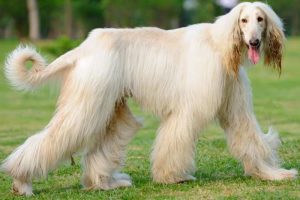 When it comes to dogs, it’s no surprise that long-haired dogs are extremely gorgeous. Unfortunately with all of the beauty and fluff that they possess, long-haired dogs come with a bit more work when it comes to grooming them. In order to groom long-haired dogs, regular bathing is a necessity. On average, you should be bathing and grooming your dog once a month with two months being the absolute longest you go in between washes. Some dogs can be groomed every other week so long as you are using a dog shampoo that is gentle. Be wary of over bathing your dog as washing too frequently can result in dry skin.
When it comes to dogs, it’s no surprise that long-haired dogs are extremely gorgeous. Unfortunately with all of the beauty and fluff that they possess, long-haired dogs come with a bit more work when it comes to grooming them. In order to groom long-haired dogs, regular bathing is a necessity. On average, you should be bathing and grooming your dog once a month with two months being the absolute longest you go in between washes. Some dogs can be groomed every other week so long as you are using a dog shampoo that is gentle. Be wary of over bathing your dog as washing too frequently can result in dry skin.
When bathing a long-haired dog, matts are a very real issue and requires plenty of patience when bathing. Be sure to use lots of pet shampoo and work from the head down. Starting at the head and then working down from the back will allow you to lather the entire coat evenly and prevent you from having to go back to any missed areas. After you scrub the back and torso, move on to spot clean areas like the belly, chest, legs, and tails. Rinse from head to toe, and then let your dog shake off all of the excess water. Especially with long-haired breeds, it is important to let your dog shake dry as it makes the drying process a lot more manageable. Air drying is the best method for your dog’s skin even though it takes the longest and it might leave your dog with a bit of a “wet dog” smell. Blow drying might lead to skin irritation. Towel drying is the happy medium wherein you can dry your dog 90% of the way and let them air dry the last 10%. Even if you air dry, remember to wipe the ears and paws at these sensitive areas to avoid bacteria grown.
After bathing, brushing should be done immediately to remove any excess dog hair that has come off during the bath. While brushing should be a daily part of your dog’s grooming routine with a long-haired dog, it is especially important in the first few days after a bath. Bathing stimulates the skin and promotes new hair growth. As a result, your dog will shed the most right after a rinse. It is crucial to help the regenerative process of hair growth by eradicating all of the hair your dog is trying to rid itself of.
Some may choose to clip their dogs coat after cleaning. If you are trying to go for a certain cut, decide on the shape you are trying to achieve and then clip small amounts at a time to ensure you don’t take too much away. Clipping is one of the most challenging and potentially scary parts of grooming a long-haired dog. Because of this, there is no shame in reaching out for professional assistance. At Olsen Veterinary Clinic, we have an in-house groomer! Contact Karen with Prancing Paws Grooming at 618-910-7581 with any questions or to schedule a grooming appointment!
One of the most integral parts of grooming is cleaning your dog’s ears. Dog’s ears are one of the most sensitive areas but also one of the most susceptible areas to nasty things like yeast infections or mites. After bathing, take time to clean the inside of your dog’s ears with cotton or a similar material that has been lightly covered in witch hazel. Be vigorous in cleaning your dog’s ears without being rough or obtrusive. It is essential to clean all of the flaps and folds inside the ear but be careful to avoid entering the ear canal.
As always, if you have any questions or concerns, feel free to contact Olsen Veterinary Clinic at 618-656-5868.
Food Allergies In Pets: What You Need To Know
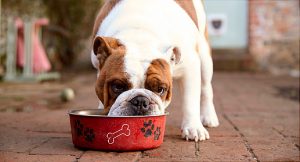 With the onset of spring, many pets are exposed to the outside environment. This has caused them to become more “itchy” and their scratching has caused discomfort to then leaving the owner searching for possible remedies. Unfortunately, their scratching and head shaking may be caused by the diet that they are fed.
With the onset of spring, many pets are exposed to the outside environment. This has caused them to become more “itchy” and their scratching has caused discomfort to then leaving the owner searching for possible remedies. Unfortunately, their scratching and head shaking may be caused by the diet that they are fed.
Many dogs and cats for that matter may suffer from food allergies. These allergies can hit about anytime during their lives and present itself with many different symptoms. These symptoms may range from odorous, greasy, dander-laced hair with chronic ear issues to maybe diarrhea with increased flatulance. Your pet may be constantly chewing on its paws, making them red and keeping you up at night with its chewing and licking. A lot of time, we will try and just mask the signs so that they can remain comfortable without diagnosing the problem. Chances are they inherited the trait from their parents.
When these signs appear, looking for the food that causes the issues may be real difficult in finding and the testing is even more difficult. Common food allergies may consist of beef, pork, chicken, corn, wheat, or a number of other ingredients. Food allergies may include one to many ingredients in the diets, so it is not as cut and dried as it may seem to just switch diets. Also blood testing is of no use in determining the allergies.
So with that said, food ingredient avoidance is the best means of controlling the allergies. So an owner may be instructed to feed a very limited ingredient diet for several weeks and see how the pet responds to the diet. Will the pet be pruritic? Will the pet’s skin be odorous? If the clinical signs are better, then you may be able to add additional ingredients and see how your pet responds.
Some owner’s will prefer to feed raw diets or homemade diets. However, those will sometimes be difficult to balance the ration to get the proper minerals and vitamins. Regardless of what you choose, do not hesitate to contact our office and we can help you navigate this issue. Contact us today.
When And How To Brush Your Dog’s Teeth
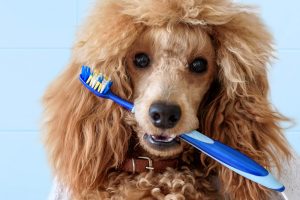 Eighty percent of dogs show signs of gum disease by the time they are two years old. The best cure for these dental issues are early prevention. Once plaque has formed on the teeth, the only way it can be removed is with a mechanical cleaning. Without brushing, this plaque build up can cause gum disease, bad breath, and tooth decay.
Eighty percent of dogs show signs of gum disease by the time they are two years old. The best cure for these dental issues are early prevention. Once plaque has formed on the teeth, the only way it can be removed is with a mechanical cleaning. Without brushing, this plaque build up can cause gum disease, bad breath, and tooth decay.
You can help your dog’s teeth by beginning dental maintenance early. In order to keep your dog comfortable while brushing its teeth, wait until your dog has all of their adult teeth before using a toothbrush. This should be around six months.In order for your dog to get comfortable with a toothbrush, you should start brushing your dog’s teeth as early as possible.
To start brushing your dog’s teeth, begin by gently rubbing your puppy’s gums with your finger. Ease into it by massaging their gums regularly while you are snuggling them. Once they are used to your finger, switch to a soft rubber brush that fits on your fingertip. Only use toothpaste that is specifically made for dogs. This comes in flavors like beef, chicken, banana, and mint. You can find this at your local pet store. Once your dog has their adult teeth, begin a weekly brushing regimen and work your way up to three to four times per week.
To begin brushing your dog’s teeth, make sure that you are in a position where your dog is comfortable. You should try kneeling or sitting in front/side of them in order to not appear threatening. If your dog seems upset, stop and try again later. Prep your toothbrush with doggy toothpaste and use small circular motions. Focus on the plaque. Slight bleeding may occur, but if heavy or ongoing bleeding occurs, stop. This might be a sign of too aggressive brushing or even gum disease. Call your vet for advice. Be sure to be reassuring while brushing your dog’s teeth. Keep the mood light and remind your dog that they are a good boy/girl. End the brushing session with their favorite treat or extra attention.
Other ways to maintain dental wellness is to provide chew toys. Teething is a part of puppy-parenting. Plenty of specially designed puppy toys will be handy in managing this teething. Mildly abrasive foods and toys help keep your dog’s teeth clean. It is important to note that you should avoid natural bones, antlers, dried cow hooves, hard nylon toys, and large rawhide toys with puppies. These are hard enough to fracture delicate puppy teeth.
Lastly, be sure to schedule dental check ups with your vet. Dogs should go to the vet twice a year for a dental exam. They might need their teeth cleaned annual. If you pup’s breath is especially stinky lately, you should call your vet. Bad breath might be a sign of dental problems or even gum disease.
As always, we are here for the health of your pet. Please contact us today if you have any questions.
Should You Eliminate Grain-Free Food From Your Dog’s Diet?
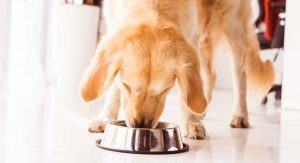 Grain free diets for dogs have recently become featured in the news. Between January 1, 2014 and April 30, 2019, the FDA received 524 reports of canine dilated cardiomyopathy (DCM). The total number of pets affected is much greater than 524, due to many households having more than one pet. The FDA is investigating a potential dietary link between DCM and dogs eating certain grain-free dog foods. The foods of concern are those containing legumes such as peas or lentils, other legume seeds, or potatoes listed as primary ingredients. The FDA began investigating this matter after it received reports of DCM in dogs that had been eating these diets for a period of months to years. DCM itself is not considered rare in dogs, but the reports are unusual because the disease occurred in breeds of dogs that are not typically prone to the disease.
Grain free diets for dogs have recently become featured in the news. Between January 1, 2014 and April 30, 2019, the FDA received 524 reports of canine dilated cardiomyopathy (DCM). The total number of pets affected is much greater than 524, due to many households having more than one pet. The FDA is investigating a potential dietary link between DCM and dogs eating certain grain-free dog foods. The foods of concern are those containing legumes such as peas or lentils, other legume seeds, or potatoes listed as primary ingredients. The FDA began investigating this matter after it received reports of DCM in dogs that had been eating these diets for a period of months to years. DCM itself is not considered rare in dogs, but the reports are unusual because the disease occurred in breeds of dogs that are not typically prone to the disease.
Canine Heart Disease or Dilated Cardiomyopathy (DCM) is a type of canine heart disease that affects the heart muscle. The hearts of dogs with DCM have a decreased ability to pump blood, which often results in congestive heart failure. Some breeds, especially large and giant breeds, have a predisposition to DCM. These breeds include Doberman Pinschers, Great Danes, Newfoundlands, Irish Wolfhounds, and Saint Bernards. While DCM is less common in medium and small breeds, English and American Cocker Spaniels are also predisposed to this condition.
The reports submitted to the FDA of affected pets span a wide range of breeds, including many without a known genetic predisposition. When early reports from the veterinary cardiology community indicated that recently, atypical cases occurred in breeds like Golden Retrievers, Labrador Retrievers, Whippets, Bulldogs, and Shih Tzus all consistently ate grain alternatives in their diets, the FDA took notice.
In the FDA’s July 2019 update on diet and canine heart disease, they examined labels of dog food products reported in DCM cases to determine whether the foods were “grain-free” (defined as no corn, soy, wheat, rice, barley, or other grains), and whether the foods contained peas, lentils, chickpeas, beans, or potatoes (including sweet potatoes). Their report states that more than 90 percent of foods reported in DCM cases were grain-free, 93 percent of reported foods contained peas and/or lentils, and 42 percent contained potatoes/sweet potatoes.
At this point in time, there is no direct and proven link between DCM and grain-free diets, but dog owners should be aware and conscious of the warning issued by the FDA.
The FDA’s July 2019 update includes the names of dog food brands that were named ten or more times in reports submitted until April 30, 2019. Most reports were for dry dog food, but raw, semi-moist, and wet foods were all represented. These foods include Acana, Zignature, Taste of the Wild, 4Health, Earthborn Holistic, Blue Buffalo, Nature’s Domain, Fromm, Merrick, California Natural, Natural Balance, Orijen, Nature’s Variety, Nutrisource, Nutro, and Rachael Ray Nutrish.
In the December 1 edition of the Journal of the American Veterinary Medical Association, Lisa M. Freeman, DVM, Ph.D., DACVN prompts that the issue is not just grain-free diets. She also suspects the “BEG” diets to be culprits. These include boutique companies, foods containing exotic ingredients, and grain-free diets. “The apparent link between BEG diets and DCM may be due to ingredients used to replace grains in grain-free diets, such as lentils or chickpeas, but also may be due to other common ingredients commonly found in BEG diets, such as exotic meats, vegetables, and fruits,” Freeman wrote. Freeman emphasizes that although there appears to be an association between DCM and BEG diets, the relationship has not yet been proven, but still practice caution in feeding BEG diets.
As a general rule of thumb, the best thing you can do for your dog is to contact your veterinarian. Feel free to contact Dr. Olsen at 618-656-5868 with any questions.
Why You Should Keep Your Pets Away from the Table This Thanksgiving
 With Thanksgiving approaching, there is no doubt that you pup is going to want to partake in the festivities. However, feeding your pup even a few tasty treats from the table is definitely not the way. More often than not, table food is typically too fatty for a dog’s digestive system and can result in severe stomach upsets. To keep your dog safe and healthy this holiday season, keep the following in mind.
With Thanksgiving approaching, there is no doubt that you pup is going to want to partake in the festivities. However, feeding your pup even a few tasty treats from the table is definitely not the way. More often than not, table food is typically too fatty for a dog’s digestive system and can result in severe stomach upsets. To keep your dog safe and healthy this holiday season, keep the following in mind.
Oily and fatty foods, which are often found on OUR tables, can lead to severe dog health problems such as diarrhea, vomiting, and pancreatitis. Even worse, there are several people foods that can be toxic to dogs. For example, onions or any food prepared with them are unsafe for dogs and should never be given to them. Moreover, dogs that are constantly fed with table scraps have the tendency to become dependent on them. Dogs that eat table scraps may start refusing to eat regular dog food. Feeding your pet with table scraps can also cause them to develop bad behaviors such as begging. If you wish to reward your pet for good behavior, give them treats made for them.
If for some reason you just cannot stop feeding your pet table scraps, follow the following rules:
No junk food! Never feed your dog junk foods such as fries, potato chips, leftover pizza, or candies. Your dog should only get healthy food items like steamed or baked potatoes, plain rice, oatmeal, bits of cooked chicken or turkey, finely chopped or steamed unseasoned veggies and certain fresh fruits.
Moderation is key! If you like giving your dog healthy people food, don’t forget to factor his meals into his daily calorie requirement, then, feed your pooch less of their own dog food so they don’t gain weight. Be sure to balance their diet since your dog still needs their regular food. Just try giving less of it on times when you are feeding him with healthy table scraps.
Watch out for toxic food! Above all, you should avoid foods that have been found to be poisonous to dogs. These include, for example, raisins, onions, chocolate, cooked bones, fruit pits, and walnuts. For a more complete list, check it out here.
If you wish to feed your dog human food, a great way to do it is to cook a recipe specifically designed for dogs. These often include scraps that pose no harm to your dog, including rice, cooked eggs, carrots, cheese, peanut butter, berries, chicken, green beans, seedless watermelon, and bananas.
As always, feel free to reach out to Olsen Veterinary Clinic with any questions at 618-656-5868.
